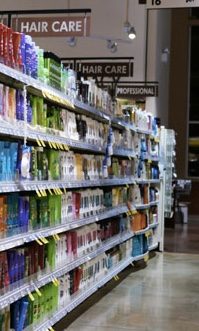Hair Care Products in the USDA BioPreferred Program
The consumer perception of traditional hair care has been changing over the last few years, as evidenced by increasing demand of more natural products that provide healthier and better results. This growing trend shifts the business focus to producing greener eco-friendly products that are, in large part, made of biological materials from agriculture, forestry or feedstocks. Manufacturers can then apply to have these products certified under the USDA BioPreferred Program, where they must meet or exceed the minimum biobased content percentage for that specific product category.
This article provides a brief comparison of biobased hair care products versus its traditional counterparts, lifting examples from the USDA BioPreferred Program product categories for hair care.
Shampoo – 66% Biobased Content
 According to the USDA BioPreferred Program, all products whose primary purpose is to clean hair belong to this product subcategory. Shampoos with conditioner need to meet the required biobased content level for shampoos to be certified under the program.
According to the USDA BioPreferred Program, all products whose primary purpose is to clean hair belong to this product subcategory. Shampoos with conditioner need to meet the required biobased content level for shampoos to be certified under the program.
Traditionally, shampoo contains synthetic petrochemical-derived detergents or surfactants as primary cleansers. Preservatives, fragrance and a number of extra ingredients are added to complete the product. Some studies have discovered that many of these synthetic ingredients are harmful, possibly causing irritation and damage to certain body organs.
Companies looking to get their shampoo products to carry the USDA Certified Biobased Product Label must meet the 66% minimum biobased requirement measured by ASTM D6866 analysis. A large part of the ingredients used to make these biobased shampoos are organic plant extracts, oils, and preservatives, promising healthier hair free of any risks.
Hair Conditioners – 78% Biobased Content
Hair conditioner is a product meant to improve and smoothen the texture of hair preventing split ends, breakage, and hair loss. It is often applied after using shampoo to contain nutrients in and create a barrier for everything that is hair damaging like grime and pollutants. These are products whose specific purpose is to improve hair condition.
Composition of conditioners differ with regards to its functionality. Some of the ingredients often found in conditioners include oils/emollients, surfactants, polymers like hydrolyzed amino acids, emulsifiers and waxes which serve as thickeners. Similar to shampoos, conditioners may also contain petrochemical-derived ingredients, e.g. paraffin wax. Natural oils often used in conditioners include jojoba oil, olive oil and grape seed oil.
For hair conditioner products to be certified under the USDA BioPreferred Program, they must meet the 78% minimum biobased content requirement. Certified products usually contain natural or organic ingredients that are not only safer for the environment but also for users.
Innovations in the hair care industry are highly advantageous for consumers who worry about the problems the product they use may cause. The United States and Europe are pushing large scale use of organic ingredients in the production of personal care products, including hair care to meet the changing perception of consumers. Experts are predicting the industry’s growth in the upcoming years. In addition, rising disposable income in Asia Pacific countries also mean that these products will be profitable in that region in the next few years. According to market research news service Fractovia, one trend that could drive the growth of the hair care industry is the development of multi-functional products, e.g. shampoo, conditioner, and hair moisturizers rolled into one.
Ready to send your biobased hair care products?
Please read the lab’s instructions for USDA Certified Biobased Product Label Applicants
USDA BioPreferred Program
The USDA BioPreferred program aims to grow and develop the market for biobased products by informing consumers, reaching out to manufacturers, and directing federal agencies to purchase them. Reports show that the program has significantly helped boost the local economy and provide millions of jobs. As of February 2018, the Program has 97 product categories. There are also biobased products in the BioPreferred Catalog deemed to be deserving of “serious purchasing consideration” but has not yet included in the mandatory purchasing categories.
References:
USDA BioPreferred Program Product Categories as of February 2018
Indian Journal of Dermatology (2015). Shampoo and Conditioners: What a Dermatologist Should Know?
doi: 10.4103/0019-5154.156355
Fractovia Industry Report (2017). Europe Personal Care Ingredients Market to be influenced by strict regulatory norms over 2017-2024 with regards to product utilization
ISO/IEC 17025:2017-accredited Beta Analytic is not affiliated with the USDA BioPreferred Program. The lab welcomes inquiries on ASTM D6866 biobased content testing as part of the Program. Please contact the lab for price inquiries.
This entry was posted on Wednesday, February 7th, 2018 and is filed under Biobased Products, USDA Biopreferred Program .